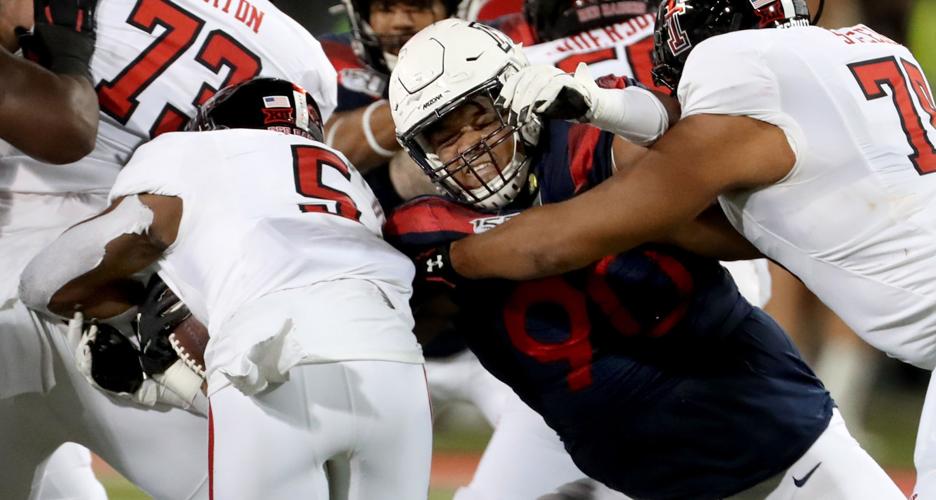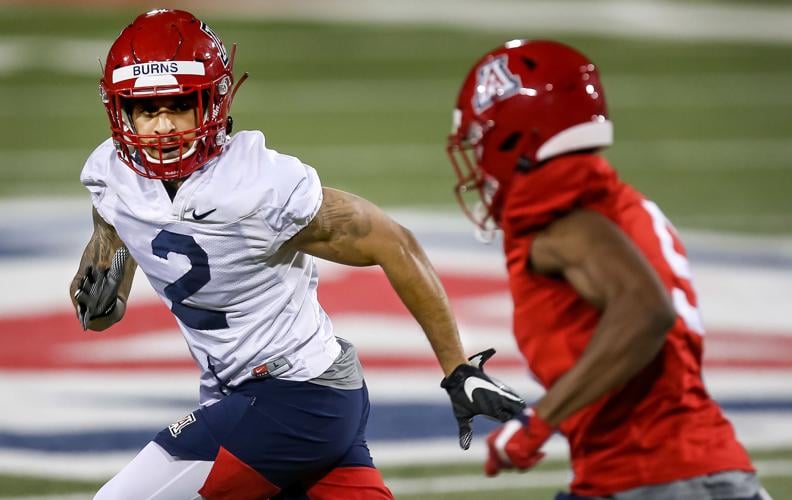Editor’s note: Each week throughout the football season, we’ll take an in-depth look at the Arizona Wildcats from a statistical perspective. Here’s the latest edition of “Cats Stats.”
Pac-12 football finally is back. So is the Star’s sports analytics department.
OK, maybe the words analytics and department are slight exaggerations. No matter: We’re here to break down the numbers for you throughout the Arizona Wildcats’ delayed, abbreviated, conference-only season.
Year 3 of the Kevin Sumlin regime is also Year 3 of “Cats Stats.” It’s our exclusive examination of UA football through a numerical lens. (It’s also super catchy, and that logo is straight fire.)

Editor’s note: Each week throughout the football season, we’ll take an in-depth look at the Arizona Wildcats from a statistical perspective.
To kick things off, we’ll take a look at seven numbers that carry significance entering the 2020 opener at Utah on Saturday.
The number(s): 0-2/2-0
The significance: The first is Sumlin’s record in season openers with Arizona. The second is his mark in Pac-12 openers. What happens when the two coincide?
If the past is truly precedent, Saturday’s game in Salt Lake City might be closer than the 14-point spread suggests.
Three of Sumlin’s four “openers” were decided by seven or fewer points. The lone exception: Arizona’s 35-14 win at Oregon State in the first game of the 2018 league season.
The Arizona Wildcats begin their season this weekend against Utah. Here are seven important stats about the state of the program.
The losses to BYU (28-23) and Hawaii (45-38) felt worse than the actual margins because Arizona was a double-digit favorite in both. The UA closed as a three-point favorite in last year’s 20-17 conference-opening win over UCLA, which also happened to be Grant Gunnell’s first career start and the only time he took every snap in a game. Speaking of which …
The number(s): 44
The significance: That’s the number of passes Gunnell threw against UCLA. It’s one fewer than predecessor Khalil Tate’s career high in four seasons. Only twice in 29 career starts did Tate have 40 or more pass attempts.
The question is whether last year’s game against the Bruins is indicative of how the UA offense will operate with Gunnell behind center. At least one aspect of that contests suggests it will be.
At no point were the Bruins and Wildcats separated by more than seven points. In other words, the game script never forced UA offensive coordinator Noel Mazzone into must-pass mode.
The game in which Tate attempted 45 passes — at Houston in 2018 — was a wipeout from the jump. The Wildcats trailed 21-0 after the first quarter and 31-0 at halftime. They had to alter their game plan, if not abandon it.
Quick side note before we move on: Arizona has more rushing yards (11,358) over the past four seasons than any Pac-12 team.

Gary Brightwell will anchor a UA rushing attack that ranks first in the Pac-12 Conference over the last four years.
The number(s): 9
The significance: That’s the highest Arizona has finished in the Pac-12 in points allowed or yards allowed over the past five seasons. Last year, the Wildcats were dead last in both. In other words, new coordinator Paul Rhoads doesn’t have a high bar to clear.
Now, we know that points allowed and yards allowed aren’t always the best indicators of defensive performance. Some prefer yards allowed per play.
How does Arizona stack up there over the past five seasons? As you might expect, not great.
The Wildcats ranked between eighth and 10th in the Pac-12 in yards allowed per play each year. Their best mark: 5.73 in 2018. Their worst: 6.36 last year.
The number(s): 4
The significance: That’s the number of returning starters on defense who are actually expected to start per the UA’s Week 1 depth chart. They are: linebackers Jalen Harris and Anthony Pandy and cornerbacks Lorenzo Burns and Christian Roland-Wallace. Two players who started six or more games last season, defensive tackle Trevon Mason and safety Christian Young, are listed with the second team.
That number would have been nearly doubled had Arizona not lost three senior starters (linebackers Tony Fields II and Colin Schooler and safety Scottie Young Jr.) to transfer. But that’s old news now. Time to move on.
The number of returning starters on Arizona’s defense is a bit deceiving in that two listed first-teamers are graduate transfers with extensive starting experience. Defensive tackle Roy Lopez started 35 games at New Mexico State. Fellow D-lineman Aaron Blackwell made 17 starts at New Mexico.
On offense, the Wildcats have six returning starters (again, using six starts last season as the threshold). Four of them — Donovan Laie, Josh McCauley, Robert Congel and Paiton Fears — are offensive linemen.
The number(s): 35
The significance: That’s the number of career starts by Burns. The fifth-year senior is tied for second among defensive players in the Pac-12 with Arizona State cornerback Chase Lucas. Oregon defensive tackle Jordon Scott paces league defenders with 37 career starts.
Burns has nine career interceptions, which puts him three away from cracking the Wildcats’ all-time top 10. Burns also needs three more pass breakups to achieve top-10 status. He has 25 in his career. The latter is more achievable given the short season.
The number(s): 58.8/34.5
The significance: The first figure is Arizona’s success rate on field goals last season. The second is the Wildcats’ net punting average. The former ranked 10th in the Pac-12 in 2019, the latter last.
Given the talent and credentials of the UA’s main specialists — kicker Lucas Havrisik and punter Kyle Ostendorp — plus Tucson’s favorable weather and elevation, those numbers fall well below expectations. The Wildcats have no excuse not to be better in the kicking game.
Arizona hadn’t made less than 60% of its field goals in a season since 2011. The strong-legged Havrisik, a senior, has a career mark of 59.4%.
Last year marked the second time in the past three that the Wildcats finished last in the Pac-12 in net punting. Ostendorp, a sophomore, shared time in 2019 with senior Matt Aragon. Significant improvement is expected from Ostendorp, who’s being pushed by freshman kicker/punter Tyler Loop.
The number(s): 7
The significance: This one didn’t require a team of researchers to unearth. It’s Arizona’s current losing streak.
The skid is the program’s longest since 2016, when the Wildcats lost eight games in a row before finishing the season with a win over Arizona State. Before that, Arizona’s last losing streak of seven-plus games occurred in 2004, its first season under Mike Stoops.
(The Wildcats lost eight straight the previous season. John Mackovic was fired halfway through that run.)
The good news is, Arizona gets a chance to start fresh Saturday. The bad news is, the losing streak endures until the Wildcats end it.
Unfortunately for them, we can’t simply stop counting the defeats.







